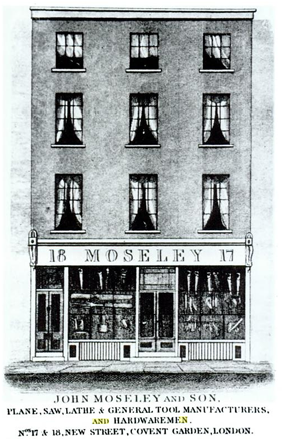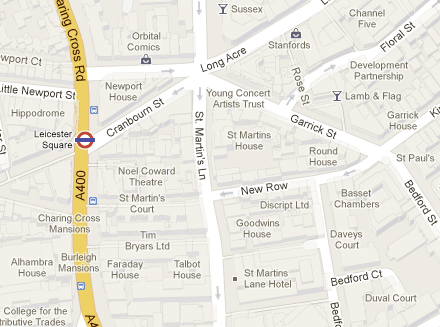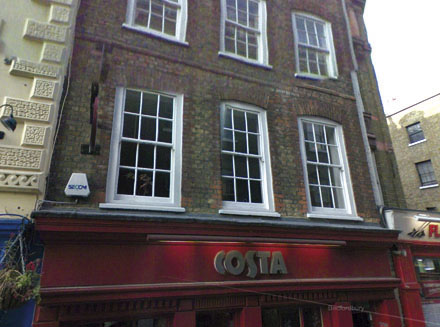Last month’s tool haul included some beautiful John Moseley ‘side-bead’ moulding planes. I’m always interested in moulding planes, but these are in particularly good condition.
John Moseley is a name that creeps cropping up in my various web searches for tools. He’s synonymous with good plane making and he’s of particular interest to me because his business address, and indeed his common maker’s mark, is usually listed as ’54-55 Broad St, Bloomsbury, London’.
Now it just so happens I cycle through the streets of London to get to work every day, and my current route takes me through the heart of Bloomsbury, so I thought I’d try and find out where his premises used to be.
The first problem I encountered is that Broad Street does not exist in Bloomsbury any more. There’s a Broad Street in neighbouring Soho, (home of the Broad Street pump, which John Snow identified as the source of the 1854 cholera epedemic), but nothing in Bloomsbury.
However, Broad Street is clearly shown on Greenwood’s famous London map of 1827, (you can see it down in the lower left corner of a section reproduced below).

Some searching later, and it’s clear there’s been a name change. Broad Street is now just an extension of High Holborn. This is confirmed on the UCL website. Of Broad Street and the area of St.Giles, they quote:
Thomas Beames, writing in the middle of the nineteenth century, described the whole area of St Giles as the type of “the lowest conditions under which human life is possible”, but he was at a loss to explain why: it was not on the river (at that time a haunt of criminals), had not had sanctuary areas (which often became criminal rendezvous places) and had been a rich area in the seventeenth century (Thomas Beames, The Rookeries of London: Past, Present, and Prospective, 2nd edn, 1852)
I’ve been searching online for some good photos of Broad Street before it turned into High Holborn. I’m hoping the wonderful people at the Camden Local Studies and Archives Centre will be able to find something. They’re very knowledgeable about the local area and think some photos might exist in a London Transport archive. If so, and if I find a picture of John Moseley’s premises, I will certainly post it on the blog.
I also found reference to a chap named Jeff Warner, who uses 19th century Sun fire insurance records, to find out a bit more about Moseley. Seems at some point, the family business moved to Covent Garden.
‘The records also helped to establish that another tool dealer, John Moseley and Son of 16-17 New Street, Covent Garden, was taken over by William Moseley in October 1828 after the death of John Moseley on 10 June 1828. More importantly, the Sun insurance records show that John Moseley was the possessor of a horse mill in the yard of his premises, which means that some kind of manufacturing was taking place, as the mill would have provided power to run a saw or perhaps a grinding wheel. This important piece of information had not been recorded in any other source.’ Link
He cites Christopher Gabriel and the Tool Trade in 18th Century London as a book which was a big help in finding out more about John Moseley and his family. And in another book that comes up as containing this information, Eighteenth-Century Woodworking Tools by James. M Gaynor, I find a picture of the Covent Garden premises, as used by William Moseley on his trade card.

I then found a few old maps of Covent Garden, including a section reproduced above from Christopher Horwood’s 26 inch to the mile Map of London, Westminster & Southwark 1799, which clearly shows New Street. However, looking at our modern day Google, the road has been renamed as New Row, although the building still seems to be there. Number 16-17 still looks the same, except for the hideous slice of retail that now underpins so many beautiful London buildings, in this case, a Costa Coffee shop.


What changes have I not seen in the line of route not many hundreds of yards in length between the eastern corner of Pall Mall and Garrick Street itself. The last-named thoroughfare was not constructed when I was young, and it owed its existence very much to the untiring efforts of Albert Smith, who did much more as a social reformer than his contemporaries gave him credit for, and who was continually protesting in the newspapers – he was the “London Scoundrel” of the Times – and in his own books and magazine articles, against a narrow and inconveniently crowded little thoroughfare called New Street, running out of St. Martin’s Lane, towards Covent Garden, which New Street is still existent, but the traffic in which has been much lightened by the building of Garrick Street, which obviously derived its name from the Garrick Club, which migrated thither from its original home, King Street. (From Victorian London – Publications – Social Investigation/Journalism – London Up to Date, by George Augustus Sala, 1895 – Three P.M. : At the National Gallery) Link

1892 William Marples & Sons acquired the business of John Moseley and Son, plane makers, London.
At Hackney Tools, we buy tools as well as sell them. If you have any planes in very good condition, with John Moseley or Moseley & Sons stamps, get in touch.




15 replies on “Being John Moseley”
Hi there,I was interested in your article as I have in my possession a wood plane similarly marked,’John Moseley& Son 54-55 Broad Street, Bloomsbury London.and the name W.Page., all on the end. Additionally the name
F Thompson is stamped along the sides about four times. The tool is in reasonable condition for it’s obvious age, still cuts wood, and measures
22 x 3.5 x 3.5 inches.I’ve had it for over fifty years, so long I forget where I acquired it, but my mother’s name was Thomson, and her brother was a joiner, and her father whom I never knew, was a furniture maker on Tyneside. I am contemplating selling it, and curious as to it’s value, any suggestions, Ian
P.S.Interesting article.
Hello Ian,
Thanks for the kind comments on the post.
Individually, Moseley planes, (side beads/hollows and rounds), are not worth a whole lot. You can find them on the dreaded eBay sometimes for around £10, or so. If you start to find half-sets, or full sets of planes, the value goes up a lot. The next best thing would be to find hollows and rounds in original pairs at least, having been kept together for their lives. Indeed, this is how most joiners and cabinet makers would have accumulated them, one sized pair at a time, as they were relatively expensive to a craftsman.
Kind regards
Gary
My great-grandfather, Ralph Johnson, was a carpenter in Detroit, Michigan, USA ca. 1900. He, or at least, his parents, emigrated from England. I have a coffin body plane marked “R. Johnson” and John Mosley & Son, 54-55 Broad St. Bloomsbury, London. I had always assumed it was contemporary with him, but from your article here, can I conclude it predates 1928 when they were at Covent Gardens?
Thanks,
Doug
Hi Doug, yes, they were at Broad St, then Covent Garden for the latter years. Best, Gary
Hi,
Moseley : New Street / New Row
I think the location is now Waterstones :
http://www.instantstreetview.com/2oaj6lz3eub0rz2ygzr5z0
Supplier of murder weapons in 1843
https://suite.io/janet-cameron/4s262je
http://www.coventgarden.uk.com/magazine/new-row-then
Kind regards,
Phil
[…] Source: hackneytools.com […]
Hi Gary, thanks for all the info on Mosely planes. I have a few that are variously stamped John Moseley and Moseley and son, but they have no street address on them. Also a snipe bill stamped Moseley, New St. Strange that they don’t have this?.They were given to me by the guy I was apprenticed to in the early 50’s. I ‘ll keep looking at your site, best Doug….
[…] of the most-read posts on Hackney Tools is about the life of tool maker John Moseley. A reader of the blog got in touch recently about a pair of mortice chisels he had been given and […]
I have an old tool box that was my Father in laws. He was born in 1892. It has a label inside the lid which is damaged, but I can read Moseley and Simpson.
17 – 18 King Street and 19 Bedford St or Road, this bit missing Covent Garden, if this is any help to anyone, it also says contents of this tool box, but the rest is missing.
I have a single plane with a flat bed and an angled, full width, blade which has the name ‘Moseley & Son London’ stamped into the end of the body. I assume a rebating use.
Do I assume that, with this name, it predates the Marples takeover in 1892 or was the name retained due to Moseley’s reputation as a maker of high quality Planes?
I have gained this plane from a friend whose husband was a carpenter/ pattern maker. The name appeared as I removed the years of grime from the body. I don’t think there are anymore where this one came from, sadly. How long had this type of plane been in use? It looks to be based on a form that could originally have been made by the tradesman. I have a small spoke-shave that is obviously ‘home made’ but is lovely to handle.
Your article was most interesting and prompted me to write.
Cheers
Jim Tomkins
Hi Jim, I don’t know, sorry. If you would like to send me a picture I might be able to shed more light on it. Send to mail@hackneytools.com. Best, gary
I have a Moseley and Sons plane and when purchased it came with a different blade then i think its suppose to have. did Moseley and sons use they own blades or out source them from another company i cant find anything on google or any website helping me out.
If anyone can shed some light on this for me that would help me
Hello Gary I have a straight razor stamped Moseley&Son New Street Covent Garden – It is in my rotation with Sheffield straights – shaves like a dream
Cheers Bart – Belgium
ps if you are interested I can send you some pics
Hello Gary, I am a Guitar Maker and used an old Mosely wooden plane to make, what I call a scooping plane. if you round off the sole of the plane on a belt sander, including the blade edge, which can later be bevelled to a cutting edge on a grindstone and then by hand on a diamond stone, you have a “scooping plane” which can be used to scoop out a “convex dish” surface which I use as a glueing board for soundboards. When I glue and clamp the fan struts in, the finished soundboard has a nice even dome-like swell. All thanks to buying an old wood plane in a junk shop and all thanks to Mr Mosely!
PS Although I do hope none of his offspring ever wore blackshirts
And no one said a word about 151 Leman St London where J.Moseley & Son
made Metal planes not only did Moseley make wood planes he also made metal infill planes gunmetal smoothers chariot planes & shoulder planes all would have had his name and address stamped on the plane and the cutting iron and if any are found today they are rarer than Norris,Spiers Preston to name a few he also made lots of other tools like Henery Norris who is famous for his planes he started as a saw maker